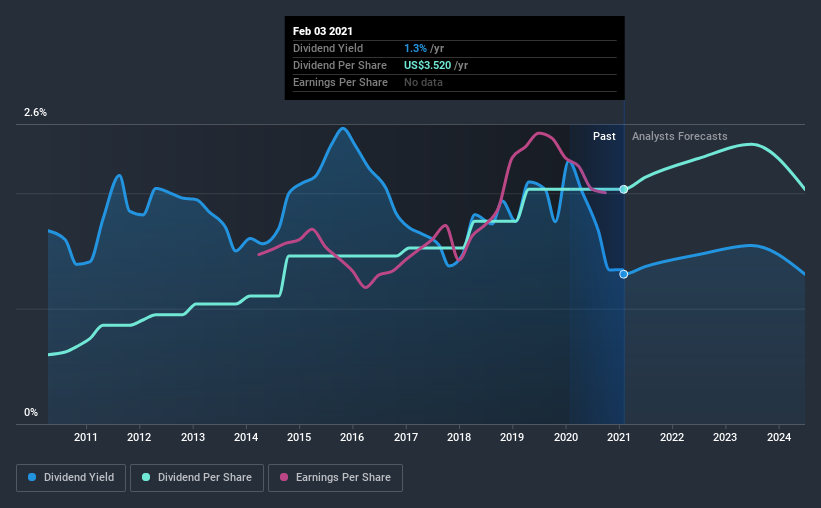Should You Buy Parker-Hannifin Corporation (NYSE:PH) For Its Upcoming Dividend?
Parker-Hannifin Corporation (NYSE:PH) is about to trade ex-dividend in the next 4 days. You can purchase shares before the 9th of February in order to receive the dividend, which the company will pay on the 5th of March.
Parker-Hannifin's next dividend payment will be US$0.88 per share, and in the last 12 months, the company paid a total of US$3.52 per share. Based on the last year's worth of payments, Parker-Hannifin stock has a trailing yield of around 1.3% on the current share price of $271.22. We love seeing companies pay a dividend, but it's also important to be sure that laying the golden eggs isn't going to kill our golden goose! As a result, readers should always check whether Parker-Hannifin has been able to grow its dividends, or if the dividend might be cut.
View our latest analysis for Parker-Hannifin
Dividends are typically paid out of company income, so if a company pays out more than it earned, its dividend is usually at a higher risk of being cut. Parker-Hannifin paid out a comfortable 38% of its profit last year. That said, even highly profitable companies sometimes might not generate enough cash to pay the dividend, which is why we should always check if the dividend is covered by cash flow. Luckily it paid out just 21% of its free cash flow last year.
It's positive to see that Parker-Hannifin's dividend is covered by both profits and cash flow, since this is generally a sign that the dividend is sustainable, and a lower payout ratio usually suggests a greater margin of safety before the dividend gets cut.
Click here to see the company's payout ratio, plus analyst estimates of its future dividends.
Have Earnings And Dividends Been Growing?
Stocks in companies that generate sustainable earnings growth often make the best dividend prospects, as it is easier to lift the dividend when earnings are rising. If earnings fall far enough, the company could be forced to cut its dividend. With that in mind, we're encouraged by the steady growth at Parker-Hannifin, with earnings per share up 5.5% on average over the last five years. Management have been reinvested more than half of the company's earnings within the business, and the company has been able to grow earnings with this retained capital. We think this is generally an attractive combination, as dividends can grow through a combination of earnings growth and or a higher payout ratio over time.
The main way most investors will assess a company's dividend prospects is by checking the historical rate of dividend growth. In the last 10 years, Parker-Hannifin has lifted its dividend by approximately 13% a year on average. It's encouraging to see the company lifting dividends while earnings are growing, suggesting at least some corporate interest in rewarding shareholders.
Final Takeaway
Should investors buy Parker-Hannifin for the upcoming dividend? Earnings per share growth has been growing somewhat, and Parker-Hannifin is paying out less than half its earnings and cash flow as dividends. This is interesting for a few reasons, as it suggests management may be reinvesting heavily in the business, but it also provides room to increase the dividend in time. We would prefer to see earnings growing faster, but the best dividend stocks over the long term typically combine significant earnings per share growth with a low payout ratio, and Parker-Hannifin is halfway there. It's a promising combination that should mark this company worthy of closer attention.
In light of that, while Parker-Hannifin has an appealing dividend, it's worth knowing the risks involved with this stock. Our analysis shows 3 warning signs for Parker-Hannifin and you should be aware of them before buying any shares.
A common investment mistake is buying the first interesting stock you see. Here you can find a list of promising dividend stocks with a greater than 2% yield and an upcoming dividend.
This article by Simply Wall St is general in nature. It does not constitute a recommendation to buy or sell any stock, and does not take account of your objectives, or your financial situation. We aim to bring you long-term focused analysis driven by fundamental data. Note that our analysis may not factor in the latest price-sensitive company announcements or qualitative material. Simply Wall St has no position in any stocks mentioned.
Have feedback on this article? Concerned about the content? Get in touch with us directly. Alternatively, email editorial-team (at) simplywallst.com.

